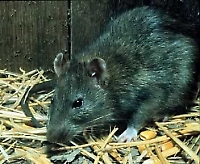"Rattus rattus" redirects here. For the album by Merzbow, see Rattus Rattus (album).
The Black Rat (Rattus rattus) (alt. Ship Rat, Roof Rat, House Rat, Alexandrine Rat, Old English Rat) is a common long-tailed rodent of the genus Rattus (rats) in the subfamily Murinae (murine rodents). The species originated in tropical Asia and spread through the Near East in Roman times before reaching Europe by the 6th century and spreading with Europeans across the world. Today it is again largely confined to warmer areas, having been supplanted by the Brown Rat (Rattus norvegicus) in cooler regions.
Despite its name, it exhibits several colour forms. It is usually black to light brown in colour with a lighter underside. A typical rat will be 15–20 cm (5.9–7.9 in) long with a further 20 cm (7.9 in) of tail. It is nocturnal and omnivorous, with a preference for grains and fruit. Compared to the Brown Rat, it is a poor swimmer, but more agile and a better climber, tending even to flee upwards. In a suitable environment it will breed throughout the year, with a female producing three to six litters of up to ten young. Females may regulate their production of offspring during times when food is scarce, throwing as few as only one litter a year. R. rattus lives for about 2–3 years. Social groups of up to sixty can be formed.
Black Rats (or their ectoparasites) are able to carry a number of pathogens, of which bubonic plague (via the rat flea), typhus, Weil's disease, toxoplasmosis and trichinosis are the most well known. In the 1920s in England, several colour variations were bred and shown alongside domesticated brown rats. This included an unusual green tinted variety. Today however, very few people keep Black Rats as pets. Most pet rats (or fancy rats) are domesticated brown rats.
In New Zealand, Black Rats have an internationally unusual distribution and importance, in that they are utterly pervasive through native forests, scrublands, and urban parklands. This is typical only of oceanic islands that lack native mammals, especially other rodents. Throughout most of the world, Black Rats are found only in disturbed habitats near people, mainly near the coast. Black Rat are the most frequent predator of small forest birds, seeds, invertebrates, and perhaps lizards in New Zealand forests, and are key ecosystem changers. Controlling their abundance on usefully large areas of the New Zealand mainland is a crucial current challenge for conservation managers.








